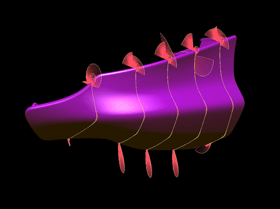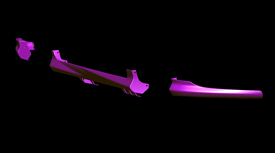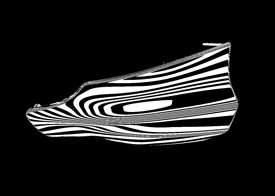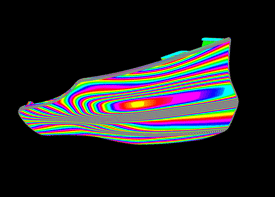Latest News
December 1, 2004
By Neil D. McLeod
If a software company told you it could help you reduce design and manufacturetimes by up to 50 percent, you probably wouldn’t believe them. But Eifel Moldand Engineering of Fraser, Michigan, is proving this claim on a daily basis aspart of the standard service it provides to its automotive clients around theworld.
This 30-year-old company has developed a set of processes that leverages thesurface modeling, analysis, and visualization facilities of the ICEM Surf softwaresuite, tying them together with other CAD tools and high-speed NC milling machinetools using a hefty dash of its development team’s intimate manufacturing experience.The result is a process the ISO9000-registered company calls simultaneous productdesign and manufacturing (SPDM).
Right: ICEM Surf helped cut tool design and manufacture time for an automotivegroundeffects package in half. This surface model display shows curvature graphs usedto determine minimums and maximums, and to indentify flat spots, sharp edges,or poor matching of components.
This process allows for the development of a product at the same time its moldtool is being designed. The result is that complex projects can be accomplished,complete with tooling, about 40 to 50 percent faster than usual.
Chrysler PT Cruiser Tuner Kit
One of Eifel’s recent projects was the Chrysler PT Cruiser tuner kit developedfor SVEA, a division of Decoma International. This project required the designof front and rear extensions and rocker panels, with aluminum tooling to be manufacturedonce the design had been completed and approved. Eifel was asked to deliver within12 weeks rather than the usual 24; and they accepted the challenge.
Below: This surface model of an entire ground effects assembly is rendered inICEM Surf’sstandard shaded mode. It is used to evaluate general form as it shows the finishedshape and how it reflects light. It is also used to evaluate fit.

Eifel started by arranging for a white light optical scan of the car sportingclay model extensions for the tuner kit. The point cloud data derived from thescan was downloaded directly into the ICEM Surf software environment.
“This part of the process is key,” says Tim Hay, senior designer at Eifel. “Thescan, once fed into ICEM Surf, gives a highly accurate 3D representation of thevehicle, allowing us to accurately locate attachment points. We are then ableto start modeling directly onto the scan, increasing accuracy and validity ofthe design from the start.”
ICEM Surf is the core surface modeling program provided by ICEM Ltd. The softwareoffers a range of modules that provide the tools Eifel uses to efficiently innovateand simultaneously manufacture. The optional add-on Scan Modeling module providesthe reverse engineering tools needed to handle dense point cloud 3D scan data.Eifel also makes extensive use of other ICEM Surf facilities that enable globalchanges to and dynamic analysis of the digital surface model while maintainingdesign characteristics and the integrity of its surfaces.
Simultaneous Product and Tool Design
Once the scan data of the tuner kit was imported into ICEM Surf, Eifel’s designteam started to virtually sculpt the parts. As in most cases, they used conceptualsketches from Decoma’s stylists for the initial working form in a digital surfacemodel. The design is created directly within the ICEM Surf environment, whichallows for full manipulation of points, Bezier surfaces, and curves to achievethe exact surface shapes required.

The zebra highlight diagnosticprovides a deeper look into surface quality. This can be based around aset lighting position, with the stripes representingthe highlights. It provides instant visual feedback as to the qualityof surfaces.
“ICEM Surf allows complete and immediate manipulation of every point in free-form,but without causing problems with the surfaces.” says Tim Martin, a senior designerfor Eifel. “Prior to using ICEM Surf, changes to a design could create unexpectederrors in the surface-bumps, waves, or gaps that can be critical as you startbuilding the tools. ICEM Surf helps us avoid this.”
Also key to Eifel’s success is its team’s combined knowledge of manufacturingprocedures. While development of the Class A surfaces (the exterior surfaces ofthe part) is underway, the team is already considering how the design will beaffected by the part’s Class B surfaces (the underside of the body panels). Theseare defined by an offset from the Class A surfaces representing the thicknessof the material. At the same time, they consider what manufacturing processesare best applied to each part of the design.
“Before we even start designing,” says Eifel’s Michael Nye, “we choose the appropriatemanufacturing process and design the mold accordingly…ICEM Surf is manufacturing-mindedand this helps us avoid violating any manufacturing rules as the design develops”.
Once the design is underway, the virtual model is shown to the clients and stylists.During these meetings changes can be made directly to the design. ICEM Surf rendersand generates highlights directly on the model so stylists can understand, change,and approve the design while the Eifel team maintains its manufacturability. Oncethis design review process is complete, Eifel engineers develop attachment methodsand work out the Class B surfaces.

Colored highlights depict areas of varying curvature and is used to visualizesurface quality with more detail than the zebra highlight diagnostic.
Surface Model to Production Tooling
While the Class A surfaces are being developed as explained above, preliminarytool design begins. At this point the tooling experts already know about the dimensions,material choices, and features of each part and are designing molds.
While all this is taking place, design and manufacturing teams review attachmentmethods together and work through design iterations, constantly reviewing to maintainspecifications.
As soon as the design is completed, the data is exported via an industry-standardneutral interface from ICEM Surf into Eifel’s machining software programs, includingproducts from Cimatron and Delcam.
“In addition to finding software tools that perfectly suit our needs and mission,“says Rick Hecker, president of Eifel Mold and Engineering, “we have also investedin high-end, high-speed milling machines. Our Tier 1 clients are relying on usto deliver quickly and accurately and as a result of our efforts, teamwork andtechnology, the Chrysler PT Cruiser tuner kit was delivered in 12 weeks, includingthe finished tools. This is about 50 percent faster than we would usually expectfor this type of project and well within the compressed timeline requested bythe client.”
It’s a timeline Eifel Mold and Engineering continues to streamline as clientscontinue to look for faster times to market.
Neil D. McLeod is a UK-based independent consultant. You can contact him aboutthis article via e-mail sent to [email protected].
Product Information
ICEM Surf
ICEM Technologies
Southampton, UK
icem.com
Delcam
Birmingham, UK
delcam.com
Eifel Mold and Engineering
Fraser, MI
eifel-inc.com
Cimatron
Givat Shmuel, Israel
cimatron.com
Subscribe to our FREE magazine, FREE email newsletters or both!
Latest News
About the Author
DE’s editors contribute news and new product announcements to Digital Engineering.
Press releases may be sent to them via [email protected].






